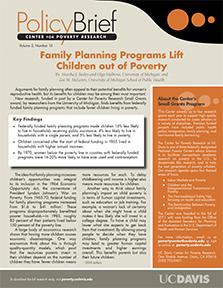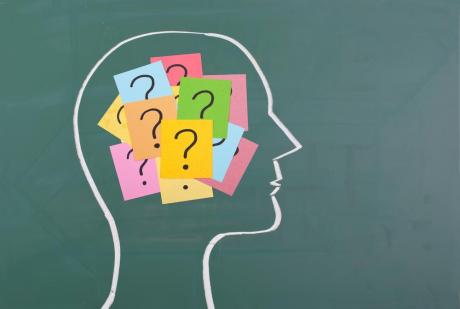Family Planning Programs Lift Children out of Poverty
by Martha J. Bailey and Olga Malkova, University of Michigan; and Zoë M. McLaren, University of Michigan School of Public Health
Arguments for family planning often appeal to their potential
benefits for women’s reproductive health, but its benefits for
children may be among their most important.
A new study, funded in part by a Center for Poverty Research Small Grants award, by researchers from the University of Michigan, finds benefits from federally funded family planning programs that include fewer children living in poverty.
Key Findings
- Federally funded family planning programs made children 15% less likely to live in households receiving public assistance, 4% less likely to live in households with a single parent, and 5% less likely to live in poverty.
- Children conceived after the start of federal funding in 1965 lived in households with higher annual incomes.
- By 1970, women below the poverty line in counties with federally funded programs were 16-20% more likely to have ever used oral contraception.
The idea that family planning increases children’s opportunities was integral to its inclusion in the 1964 Economic Opportunity Act, the cornerstone of President Lyndon Johnson’s War on Poverty. From 1965-70, federal funding for family planning programs increased from $1.6 to $41 million (2008 dollars). These programs disproportionately benefitted poorer households—in 1983, roughly 83 percent of their patients lived below 150 percent of the poverty line.
A large body of economics research shows that having more children causes economic disadvantage. One way economists think about this is through quality-quantity models, which posit that the resources parents invest in their children depend on the number of children they have: fewer children means more resources for each. To delay childbearing until income is higher also means more resources for children.
Another way to think about family planning’s impact on child poverty is in terms of human capital investments, such as education or job training. For example, a woman’s lack of certainty about when she might have a child makes it less likely she will invest in a college degree. To have a child may lower what she expects to get back from that investment. By allowing young people to decide when they have children, family planning programs may lead to greater human capital investments and higher earnings overall. This benefits parents but also their future children.
Data on Children and Family Planning
Programs
To measure the impact of family planning programs that were
federally funded between 1964 and 1973, researchers compared the
economic resources and living circumstances of children born in
more than 660 counties before and after those family planning
programs began.
Researchers used three major bodies of data to conduct their
examination.
Restricted-use census data from the University of Michigan
Research Data Center provided a much larger sample of the U.S.
population than does public data, and includes critical
geographic information needed to compare proximities to federal
family planning programs. The 1970 census data provided a picture
of children born in the early 1960s before the programs began.
The 1980 census data showed possible outcomes for children six
years after the federal programs were established.
Researchers also used information compiled from the U.S. Office of Economic Opportunity (OEO) and the 1970 National Fertility Study (NFS) to examine contraceptive use. The OEO survey was sent to all known providers of family planning in the fiscal years 1968, 1969 and 1971. The NFS surveyed women between the ages of 18 and 44 who had ever been married about whether they had ever used a family planning clinic, regardless of whether it was federally funded. It also asked whether they had ever used oral contraception, the most popular and inexpensive contraceptive method at that time.
Family Planning and Child Poverty
This study has found that the introduction of federally funded
family planning programs has impacted child poverty. Children
born after the establishment of the federally funded programs
were significantly less likely to live in households with income
below the poverty line. They were five percent less likely to
live in poverty and 15 percent less likely to live in households
receiving public assistance. The study also found that the share
of children living in single-headed households fell by four
percent among cohorts born after family planning programs began.
These results held when researchers considered white and nonwhite children separately. In counties with the federally funded programs, the share of white children living in households below 150 percent of the poverty line was lower by 0.8 percentage point, which is 2.5 percent lower than the overall 1970 average. The impact on African American children is larger in absolute terms (1.53 percentage points) but implies a similar reduction of 2.4 percent.
The findings also suggest that family planning programs improved economic well-being enough to reduce the share of children in households that receive welfare payments, especially among white children. The average impact on white children in those counties was 0.76 percentage point—a reduction of 15 percent.
The establishment of federal family planning appears to have stemmed the growth of nonwhite children in households receiving welfare but did not reduce their numbers.
Contraception among Women in Poverty
The study found that after federal family planning programs
began, the number of poor women using the services in those
counties grew about twice as fast as the national average. The
increase in the number of poor women using the Pill was also
greater in those counties. By 1970, those women were also 16- to
20-percent more likely to have ever used oral contraception. In
fact, in counties with federally funded family planning programs,
use of the Pill was as common between poor and non-poor women.
Use of the Pill was also about four percent higher among women
above the poverty line.
Meet the Researchers
Martha J. Bailey is an Associate Professor of Economics
at the University of Michigan, where she is also a Research
Affiliate for the National Poverty Center and a Research
Associate Professor at the Population Studies Center.
Olga Malkova is a Ph.D. candidate in Economics at the University of Michigan. Her research interests include labor force participation, retirement and aging, inter-generational transfers, public policy and fertility.
Zoë M. McLaren is an Assistant Professor at the University of Michigan School of Public Health. Her research examines how health status influences economic outcomes in developing countries.













